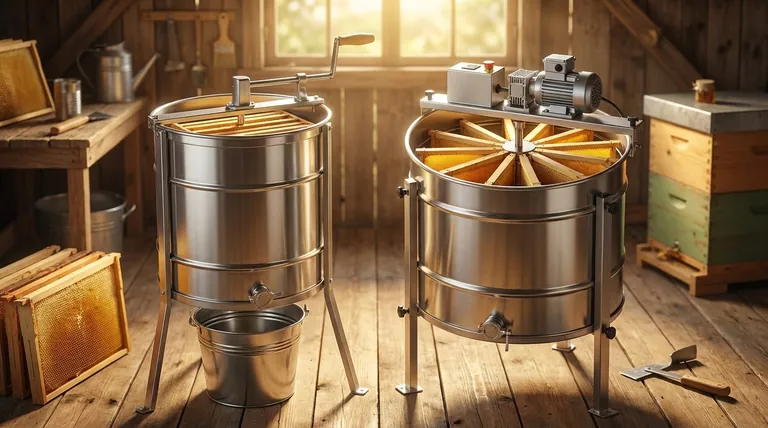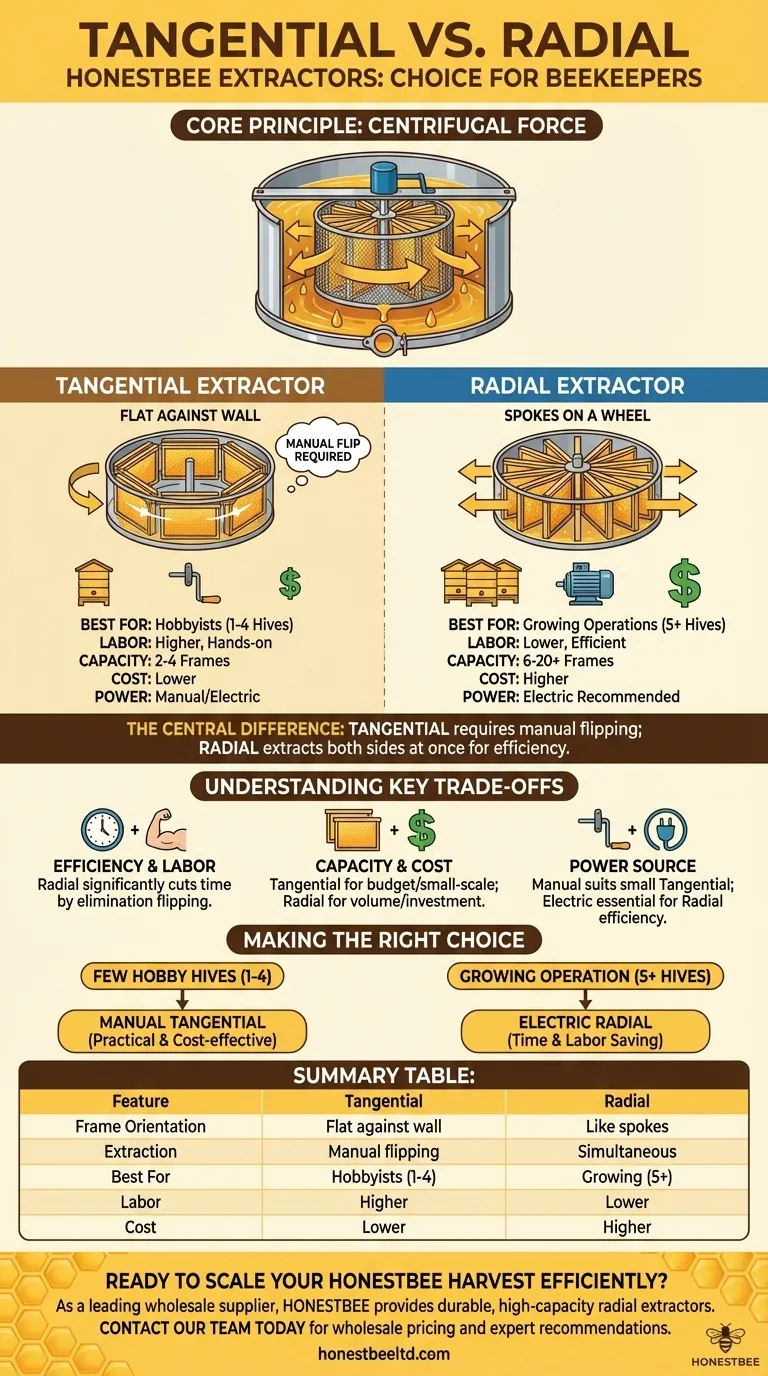For small and medium-scale beekeepers, the two dominant styles of honey extractors are the Tangential Extractor and the Radial Extractor. Each uses centrifugal force to pull honey from the comb, but their design dictates their efficiency, capacity, and the amount of labor required during harvest.
The central difference is simple: Tangential extractors require you to manually flip the frames to extract both sides, making them suited for hobbyists. Radial extractors extract both sides at once, offering a significant efficiency gain for growing apiaries.

The Core Principle: Centrifugal Force
How Extraction Works
At its heart, a honey extractor is a simple machine. It's a large drum with an internal basket that holds the honey frames.
When the basket spins, it generates powerful centrifugal force. This force slings the liquid honey outward from the uncapped beeswax comb, where it hits the inner wall of the drum and drips down to a collection point at the bottom.
Tangential vs. Radial: A Detailed Comparison
The key difference between the two styles lies in how the frames are positioned inside the extractor's basket. This single design choice has major implications for your workflow.
The Tangential Extractor
In a tangential extractor, the frames are placed flat against the side of the circular basket, much like clothes in a spin dryer.
This orientation means the centrifugal force acts on the outer-facing side of the honey comb exclusively. To extract the other side, you must stop the machine, manually flip each frame, and spin it again.
These extractors are typically less expensive and are a common starting point for new beekeepers with only a few hives.
The Radial Extractor
In a radial extractor, the frames are loaded like spokes on a wheel, with the top bar of the frame facing the outer wall of the drum.
As the basket spins, honey is pulled from both sides of the frame simultaneously. The slight upward angle of the cells in the comb helps direct the honey outward.
This design eliminates the need to flip frames, drastically reducing the time and labor required for extraction.
Understanding the Key Trade-offs
Choosing between these two styles involves balancing cost against efficiency and the scale of your operation.
Efficiency and Labor
A radial extractor is significantly more efficient. Eliminating the step of flipping frames can cut your extraction time by nearly half, a crucial factor when processing honey from more than three or four hives.
The tangential style is inherently more hands-on. While this offers a greater degree of control, the process is slower and more labor-intensive.
Capacity and Cost
Tangential extractors are generally smaller, holding between two and four frames. Their simpler design makes them the more affordable option, ideal for hobbyists on a budget.
Radial extractors are built to handle a larger volume, often holding anywhere from six to over twenty frames. This higher capacity and more complex design come with a higher price tag.
Power Source: Manual vs. Electric
Both tangential and radial models come in manual (hand-crank) and electric versions. A manual extractor is perfectly suitable for a small tangential unit.
However, for a radial extractor, an electric motor is almost a necessity. It provides the consistent, high-speed spin needed to extract honey from both sides of the comb effectively and unlocks the machine's true time-saving potential.
Making the Right Choice for Your Apiary
Your decision should be based on the current size of your apiary and your future ambitions.
- If your primary focus is managing a few hobby hives (1-4): A manual tangential extractor is the most practical and cost-effective solution for your needs.
- If your primary focus is growing your operation (5+ hives) or maximizing efficiency: Investing in an electric radial extractor will save you significant time and labor during harvest.
Ultimately, selecting the right extractor is about matching the tool to the scale of your work.
Summary Table:
| Feature | Tangential Extractor | Radial Extractor |
|---|---|---|
| Frame Orientation | Flat against the drum wall | Like spokes on a wheel |
| Extraction Process | Requires manual frame flipping | Extracts both sides simultaneously |
| Best For | Hobbyists with 1-4 hives | Growing operations with 5+ hives |
| Labor Intensity | Higher (more hands-on) | Lower (more efficient) |
| Typical Cost | Lower | Higher |
Ready to scale your honey harvest efficiently?
As a leading wholesale supplier to commercial apiaries and distributors, HONESTBEE provides the durable, high-capacity radial extractors that growing operations need to maximize yield and minimize labor. Let us equip your business for success.
Contact our team today for wholesale pricing and expert equipment recommendations.
Visual Guide

Related Products
- Electric 8 Frame Honey Spinner Extractor Equipment for Beekeeping
- HONESTBEE 72 Frame Industrial Electric Honey Extractor for Beekeeping
- HONESTBEE 3-Frame Manual Acrylic Honey Extractor
- electric honey extractor honey centrifuge 3 frame honey extractor stainless steel honey frame extractor
- 6 Frame Manual Stainless Steel Honey Extractor Beekeeping Equipment
People Also Ask
- What machines are needed in beekeeping besides basic tools? Scale Your Honey Harvest Efficiently
- What equipment is needed for extracting honey? A Complete Guide for Every Beekeeper
- What are the differences between manual and electric honey extractors? A Beekeeper's Guide to Power, Speed & Cost
- How long should you spin honey for? Master the Art of Efficient, Safe Extraction
- What is an extractor in beekeeping? Unlock Sustainable Honey Harvesting



















